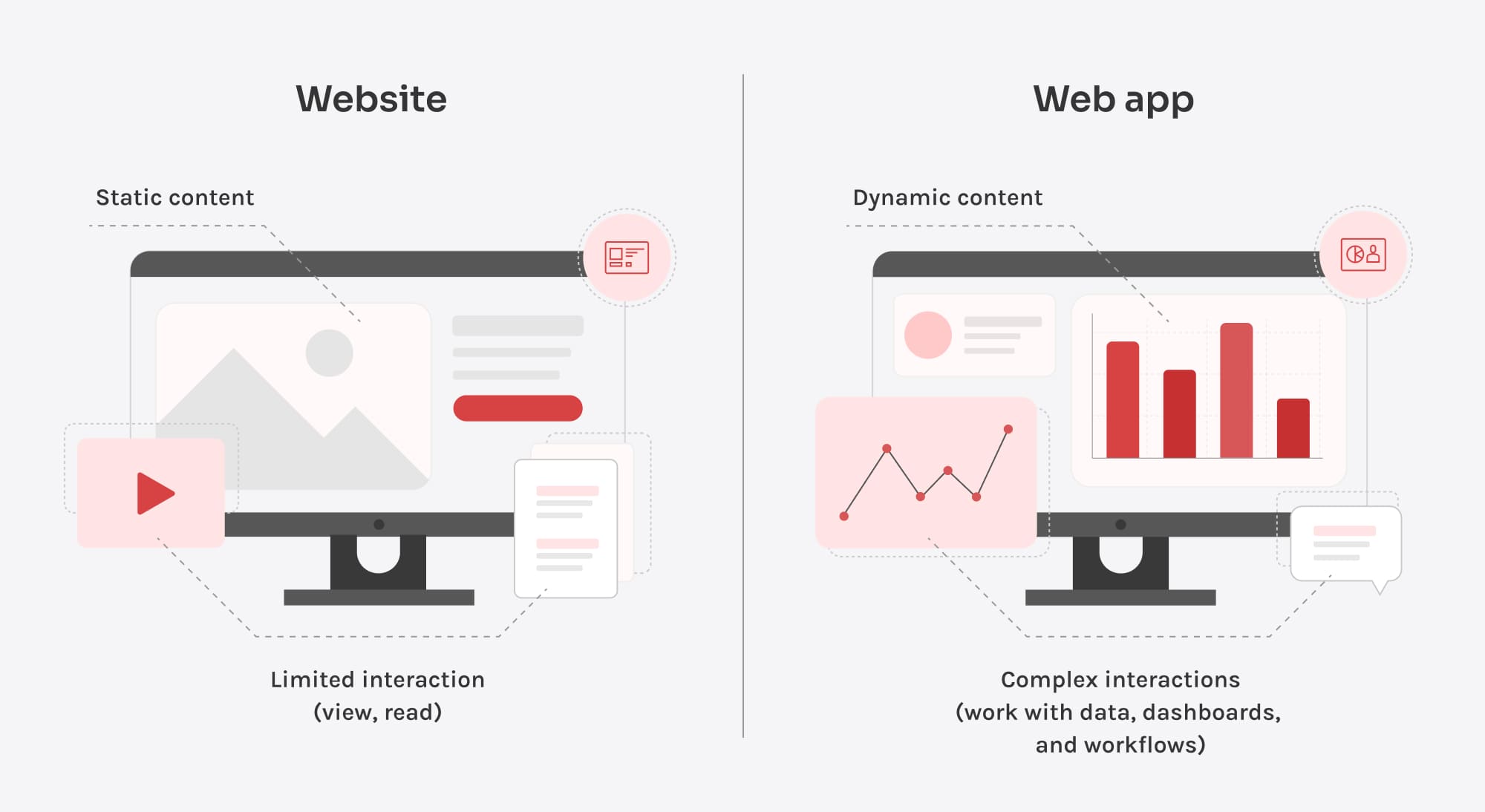Ihre Nachricht wurde gesendet.
Wir werden Ihre Anfrage bearbeiten und uns so schnell wie möglich mit Ihnen in Verbindung setzen.
Das Formular wurde erfolgreich abgeschickt.
Weitere Informationen finden Sie in Ihrem Briefkasten.

Sprache auswählen



Stellen Sie sich Folgendes vor: Sie sind Inhaber eines Kleinunternehmens und möchten Ihren Umsatz steigern. Deshalb starten Sie eine Web-App, um das mobile Einkaufserlebnis zu verbessern. Sie investieren zwar ein paar Tausend Euro, doch der Traffic ist geringer als erwartet, und die Kunden bleiben Ihrer mobil optimierten Website treu. Was ist also schiefgelaufen? Es stellte sich heraus, dass Ihre Kunden keine separate Web-App benötigten – die mobil optimierte Website entsprach bereits perfekt ihren Bedürfnissen.
Es passiert (und zwar häufig). Manchmal investieren Unternehmen in eine Web-App, weil sie denken, dass dies der beste Weg ist, das mobile Erlebnis zu verbessern, stellen dann aber fest, dass die Investition unnötig und kostspielig ist.
Das bringt uns zur Frage: Was ist besser - eine Web-App oder eine Website? In diesem Blogbeitrag erläutern wir die wichtigsten Unterschiede, die wichtigsten Geschäftsfragen und die häufigsten Fallstricke, die Sie bei Ihrer Entscheidung vermeiden sollten. Am Ende wissen Sie genau, was für Sie am besten geeignet ist.
Betrachten Sie die Debatte „Web-App vs. Website“ bei der Planung Ihres nächsten digitalen Projekts nicht als reine Formalität. Berücksichtigen Sie Ihre individuellen Ziele und Ihre geplante Entwicklung im Laufe der Zeit. Dazu gehören der Online-Auftritt Ihres Unternehmens, die Interaktion der Nutzer mit Ihnen und die reibungslose Ausführung von Backend-Operationen.
Eine Website ist beispielsweise Ihre digitale Zentrale und dient als zentraler Ort für Ihr gesamtes Geschäftsangebot. Das bedeutet, dass Websites auf Unternehmen ausgerichtet sind, die ihre Markenbekanntheit steigern, Leads generieren und die SEO-Leiter verbessern möchten.
Gleichzeitig eignen sich Web-Apps ideal für Unternehmen, die die Benutzereinbindung fördern, Echtzeit-Interaktionen ermöglichen oder interne Arbeitsabläufe unterstützen möchten. Da sie Klient- und Serverseitig dynamische Logik ausführen, integrieren sie sich direkt in Ihre Backend-Systeme und passen sich dem Nutzerverhalten an. Das bedeutet weniger manuelle Schritte, schnellere Reaktionen und Prozesse ohne Engpässe.
Es versteht sich von selbst, dass eine falsche digitale Einrichtung das Kundeninteresse oder die Marktnachfrage einschränken und so Geschäftschancen entgehen kann. Überlegen Sie sich daher gut, was zu Ihnen passt. Lassen Sie uns die Unterschiede zwischen einer Web-App und einer Website genauer betrachten.
“Die Entscheidung zwischen einer Website und einer Web-App beeinflusst alles – von der Nutzererfahrung bis zum ROI. Wir helfen Ihnen herauszufinden, was wirklich zu Ihren Geschäftszielen passt, Ihre Nutzer zufriedenstellt und Ihr Budget nicht sprengt.”

Chief Technology Officer
Was ist also der Unterschied zwischen einer Website und einer Anwendung? Besonders bemerkenswert ist, dass die Grenzen zwischen Websites und Apps in den letzten Jahren zunehmend verschwimmen.
Wie unterscheiden sich webbasierte Anwendungen und Websites? Ist eine Website eine Anwendung? Die Antworten sind nicht mehr so eindeutig wie früher. Technisch gesehen ist jede Webanwendung eine Website (da der Zugriff über das Internet erfolgt), aber nicht jede Website ist eine Webanwendung. Websites nutzen heute jedoch Funktionen, die früher nur Apps vorbehalten waren, und werden interaktiver als je zuvor.
Es gibt auch benutzerdefinierte Webportale – im Grunde Web-Apps, die wie normale Websites aussehen. Wenn Sie sich damit anmelden, interagieren und Ihre Daten verwalten können, sind Sie definitiv im App-Bereich.
Kennen Sie Progressive Web Apps (PWA)? Das sind Websites, die sich wie mobile Apps verhalten, nur dass Sie sie nicht aus dem App Store oder Google Play herunterladen müssen. Aber das ist ein ganz anderes Thema. Kommen wir zurück zum Thema Web-App vs. Website.
Für viel beschäftigte Unternehmer bedeutet Entscheidungsfindung, den Überblick zu behalten und sich auf das Wesentliche zu konzentrieren. Hier ist ein kurzer Vergleich der wichtigsten Faktoren, der Ihnen hilft, die beste Lösung für Ihr Unternehmen zu finden, ohne sich in technischen Details zu verlieren.
Websites dienen Nutzern als wichtiger Anlaufpunkt für statische Inhalte – Inhalte, die sie ansehen und lesen können. Sie bieten ein einfaches, informatives Erlebnis, das hilfreich und nicht aufdringlich wirkt.
Web-Apps hingegen sind mit ihren aktuellen Updates und leistungsstarken Einkaufstools deutlich dynamischer. Sie ermöglichen es Nutzern, Daten zu bearbeiten, mit Dashboards zu interagieren, Workflows anzupassen und vieles mehr.
Meine erste Empfehlung lautet: Betrachten Sie Entwicklungskosten nicht als Belastung, sondern als strategische Investition.
Wenn man die Komplexität und die Kosten der Website- und Web-App-Entwicklung abwägt, erscheint die erste Option einfacher und günstiger. Eine Website lässt sich mithilfe vorgefertigter Lösungen und Vorlagen schnell starten, was die Entwicklungskosten senkt und die Markteinführungszeit verkürzt.
Eine Web-App hingegen ist ein voll funktionsfähiges System mit Benutzerinteraktionen, Datenbanken, Integrationen mit anderen Diensten und natürlich regelmäßigen Updates zur Aufrechterhaltung von Sicherheit und Funktionalität. Angesichts des hohen Funktionsumfangs kann eine solche Lösung nicht günstig sein. Web-Apps erfordern zudem laufende Wartung, was die langfristigen Kosten erhöht.
Websites sind einfach zu verwalten – weniger Updates, weniger Aufwand. Web-Apps? Ganz anders. Sie erfordern regelmäßige Pflege: Feature-Rollouts, Fehlerbehebungen und Leistungsoptimierungen, aber der Grad an Anpassungsmöglichkeiten und Flexibilität, der dadurch erreicht wird, ist unübertroffen.
In puncto Sicherheit und Compliance erfordern Web-Apps zweifellos erhöhte Sicherheits- und Compliance-Maßnahmen. Sie verarbeiten und speichern Nutzerdaten, integrieren sich häufig in andere Dienste und nutzen komplexe Authentifizierungsmechanismen. All dies erhöht das Risiko von Sicherheitslücken, weshalb eine sorgfältige Überwachung unerlässlich ist. Websites benötigen in der Regel nur grundlegende Maßnahmen wie Cookie-Benachrichtigungen, was ihre Sicherheit vereinfacht.
Noch ein wichtiger Punkt: Sicherheit darf nicht vernachlässigt werden. Sie ist nicht optional. Sie hat immer oberste Priorität. Bedenken Sie, dass selbst eine einfache Website zum Angriffsziel werden kann, wenn grundlegende Sicherheitsstandards vernachlässigt werden.
Ich habe alle Punkte in einer einfachen, übersichtlichen Tabelle zusammengefasst.
| Faktor | Website | Web-App |
| Interaktivität | Eingeschränkte Interaktion (Formulare, Browsen) | Komplexe Interaktionen (Dashboards, Automatisierung) |
| Entwicklungskomplexität | Schneller Aufbau dank Vorlagen und Standardfunktionen | Erfordert individuelle Entwicklung und laufende Updates |
| Kosten | Niedrigere Vorlaufkosten | Höhere Anschaffungskosten, langfristigere Investitionen |
| Wartung | Geringer Wartungsaufwand, hauptsächlich Inhaltsaktualisierungen | Erfordert kontinuierliche Updates und Skalierungspläne |
Sollten Sie sich für eine einfache Website entscheiden oder in eine vollwertige Web-App investieren? Jede Lösung hat ihre eigenen Vor- und Nachteile. Hier erfahren Sie, worauf Sie sich zunächst konzentrieren sollten.
Ich denke, der Schlüssel zur Entscheidung zwischen einer Website und einer Web-App liegt darin, Ihre Geschäftsziele und die Bedürfnisse Ihrer Zielgruppe zu verstehen.
Wenn Ihr Hauptziel darin besteht, Markenbekanntheit zu steigern, Inhalte zu teilen und Traffic zu generieren, ist eine Website wahrscheinlich das Richtige für Sie. Sie eignet sich hervorragend, um Ihre Botschaft zu verbreiten und ein breites Publikum zu erreichen.
Wenn Ihr Unternehmen jedoch Prozesse optimieren, Automatisierung anbieten oder eine komplexere SaaS-Lösung bereitstellen möchte, ist eine Web-App die richtige Wahl. Wie bereits erwähnt, bietet sie Ihnen deutlich mehr Flexibilität, Interaktivität und ein personalisiertes Erlebnis basierend auf Echtzeitdaten, was eine herkömmliche Website nicht so gut leisten kann. Denken Sie auch an die Benutzererfahrung – wenn Sie ein hohes Maß an Interaktivität und Anpassung benötigen, ist eine Web-App dafür deutlich besser geeignet.
Bei Ihrem Projekt ist das Budget das zentrale Thema. Kurz gesagt: Ihre Entscheidung für eine Web-App oder eine Website hängt maßgeblich von finanziellen Überlegungen ab. Die geringeren Anschaffungskosten und der schnellere ROI machen Websites für Unternehmen attraktiv, die schnell und ohne große Anfangsinvestitionen online präsent sein möchten. Web-Apps hingegen erfordern höhere Anfangsinvestitionen, sowohl in der Entwicklung als auch in der laufenden Wartung. Wenn Sie also ein starkes Wachstum planen oder komplexe Anforderungen haben, kann sich eine Web-App aufgrund der deutlich höheren Rendite lohnen.
Die Markteinführungszeit hängt maßgeblich davon ab, ob Sie schnell einsatzbereit sein müssen oder nachhaltiges Wachstum planen. Websites sind schnell verfügbar und daher ideal für Unternehmen, die schnell mit grundlegenden Funktionen online gehen müssen. Wie Sie sich vielleicht vorstellen können, sind für eine effektive Skalierung mit dem Unternehmenswachstum möglicherweise größere Upgrades erforderlich. Das bedeutet spätere Mehrkosten. Web-Apps hingegen haben aufgrund ihrer Komplexität und der individuellen Funktionen einen längeren Entwicklungszyklus.
Die folgende Tabelle soll Ihnen einen ersten Überblick darüber verschaffen, wann Sie eine Website benötigen und wann Ihr Unternehmen eine Web-App braucht.

Beim Design einer Website oder Web-App gilt: Für eine erfolgreiche Umsetzung benötigen Sie höchstwahrscheinlich ein spezialisiertes Team. Und genau hier liegen die Fallstricke.
Lassen Sie uns das klären. Sie waren sich unsicher, was Sie wählen sollten: eine Web-App oder eine Website? Sie haben einen Entwicklungspartner ausgewählt, der Ihnen gut zu passen schien, ohne dessen Expertise oder bisherige Arbeit gründlich zu prüfen. Oder vielleicht haben Sie sich nur wegen der niedrigen Anschaffungskosten für ihn entschieden.
Sie haben das Projekt gestartet. Das Team hat Ihnen bei der Auswahl geholfen, ohne Ihre Geschäftsanforderungen zu verstehen. Warum war das ein Problem? Sie haben Sie von Anfang an zur falschen Lösung geführt. Sie könnten am Ende eine Web-App haben, obwohl Sie nur eine optimierte Website benötigten. Oder Sie haben sich mit einer einfachen Website zufrieden gegeben, die die von Ihren Nutzern erwarteten Funktionen nicht bietet.
So eine Situation kann entstehen, wenn Sie den falschen Partner an Ihrer Seite haben. Was also sollten Sie tun, um diese bedauerlichen Folgen zu vermeiden?
Zunächst ist es wichtig, die bevorstehende Arbeit klar zu verstehen. Web-Apps erfordern erfahrene Entwickler mit umfassendem Verständnis für sauberen Code sowie Kenntnissen in den Bereichen Sicherheit, Datenbankarchitektur und API-Integration. Solche Projekte erfordern in der Regel aufwendige Benutzer-Workflows, Datenmanagement und ein skalierbares Framework. Planung und Abkürzungen sind daher nicht möglich.
Obwohl Websites in der Regel weniger komplex sind, erfordern sie dennoch einen strategischen Ansatz. Entwickler können zwar die Erstellung übernehmen, aber echter Erfolg hängt von mehr als nur einem sauberen Website-Design ab. Ohne fundierte Kenntnisse der besten SEO-Praktiken, des User Experience (UX)-Designs und der Performance-Optimierung besteht selbst bei der ansprechendsten Website die Gefahr, in den Suchergebnissen unterzugehen.
Anstatt Ihr zuverlässiges Traumteam mit Herz und Bauchgefühl auszuwählen, lassen Sie sich von Fakten leiten. Im Zusammenhang mit den Entwicklungspartnern bedeutet dies echte Projekte mit echten, vertrauenswürdigen Ergebnissen.
Ein bekanntes europäisches Transportunternehmen hatte Schwierigkeiten, seine stetig wachsende Fahrerflotte und sein wachsendes Support-Team zu steuern. Neben dem gestiegenen Betriebsumfang erforderte die Optimierung der Fahrerplanung, der Lohn- und Gehaltsabrechnung sowie der Kommunikation zusätzliche Tools.
Das Unternehmen suchte nach Möglichkeiten, die Effizienz zu steigern, ohne zu hohe Kosten zu verursachen und gleichzeitig die Benutzerfreundlichkeit zu berücksichtigen. Es stand vor der Entscheidung zwischen einer traditionellen Website und einer dynamischeren Web-App. Ziel war es herauszufinden, welche Lösung die Anforderungen an Echtzeit-Tracking, Personalmanagement und Betriebseffizienz am besten erfüllt.
Sie wandten sich an Innowise, einen führenden Anbieter von Webentwicklungsdienstleistungen. Unser erster Schritt bestand darin, eine Beratung durchzuführen, um die zugrunde liegenden Probleme des Unternehmens zu identifizieren. Die wichtigsten Anliegen waren:
Nach Prüfung dieser Anforderungen schlug Innowise einen progressiven App-Entwicklungsservice vor. Warum? Sehen Sie sich an, was PWAs bieten:
Die Ergebnisse waren sofort sichtbar:
Wir unterstützten unseren Kunden bei der Auswahl der optimalen Lösung, die seinen Bedürfnissen und Geschäftszielen am besten entsprach. Durch die Auslagerung der SaaS-Website-Entwicklung an unser Team erzielte der Kunde sowohl sofortige Ergebnisse als auch eine skalierbare Grundlage für langfristiges Wachstum.
Es lohnt sich, es noch einmal zu wiederholen: Die Auswahl einer Website oder Web-App ist nicht nur eine Frage der Technologie, sondern ein entscheidender Schritt, der den Gesamterfolg Ihrer digitalen Strategie bestimmen kann. Gehen Sie den falschen Weg – riskieren Sie, Ihr Budget zu überziehen, das Wachstum zu bremsen und etwas zu entwickeln, das Ihren tatsächlichen Bedürfnissen überhaupt nicht entspricht. Hier erfahren Sie, wo oft etwas schiefgeht und wie Sie es vermeiden können.
Wenn Ihr Unternehmen hauptsächlich eine Online-Präsenz benötigt, um Informationen zu teilen, die Markenbekanntheit zu steigern oder Content-Marketing zu unterstützen, reicht meiner Meinung nach eine Website aus. Eine benutzerdefinierte Web-App ist ideal, wenn Sie komplexe Benutzerinteraktionen, Echtzeit-Updates oder erweiterte Integrationen benötigen. Wenn Sie jedoch noch nicht so weit sind, bedeutet der Einstieg mit einer Web-App, für Funktionen zu bezahlen, die Sie nicht benötigen, und eine Komplexität zu akzeptieren, die Sie ausbremsen kann.
Tipp: Entscheiden Sie sich für eine Website, wenn Ihnen Geschwindigkeit, Einfachheit und Sichtbarkeit am wichtigsten sind. So erhalten Sie schnell einen ansprechenden Online-Auftritt, ohne Ihr Budget zu sprengen. Sobald Sie einen echten Bedarf an interaktiven Funktionen oder Automatisierung feststellen, können Sie Ihre Website mit einem klaren Ziel und einer Roadmap zu einer leistungsfähigeren Website weiterentwickeln.
Web-Apps verarbeiten häufig Benutzeranmeldungen, Zahlungsinformationen oder vertrauliche Geschäftsdaten und sind daher anfälliger für Cyberangriffe. Wenn Teams Starttermine priorisieren und Sicherheit als zweitrangig betrachten, gefährden sie die Benutzersicherheit und untergraben das Vertrauen – zwei Faktoren, die, einmal verloren, nur schwer wiederhergestellt werden können.
Tipp: Nehmen Sie Sicherheit und Compliance in Ihren Prozessen vom ersten Tag an ernst. Nutzen Sie sichere Authentifizierung, verschlüsseln Sie vertrauliche Daten, befolgen Sie Best Practices für die DSGVO oder andere Vorschriften und führen Sie regelmäßige Schwachstellenprüfungen durch. Eine sichere Grundlage schützt nicht nur Ihre Benutzer, sondern vor allem Ihre Marke.
Eine Lösung, die für 100 Nutzer gut funktioniert, kann unter der Last von 10.000 Nutzern zusammenbrechen. Das bedeutet nicht, von Anfang an zu viel zu programmieren – es bedeutet, sorgfältige Entscheidungen über Plattformen, Frameworks und Architektur zu treffen, die mit Ihnen wachsen können.
Tipp: Priorisieren Sie modulares Design, flexibles Hosting und Plattformen, die Add-ons oder Integrationen unterstützen. Wählen Sie von Anfang an Tools und Technologien, die Sie in Zukunft nicht einschränken.
Viele Unternehmen konzentrieren ihre gesamte Energie (und ihr gesamtes Budget) auf die Einführungsphase, erkennen dann aber zu spät, dass die Wartung kontinuierliche Aufmerksamkeit und Investitionen erfordert. Laufende Kosten wie Servergebühren, Software-Updates, Sicherheitspatches, Leistungsoptimierung und Funktionsverbesserungen können sich schleichend anhäufen.
Tipp: Wartung bedeutet, das Nutzererlebnis zu verbessern, die Leistung zu optimieren und die Funktionen hinzuzufügen, die Ihre Nutzer tatsächlich benötigen, während Ihr Unternehmen wächst. Planen Sie Budget und Ressourcen für regelmäßige Updates, technischen Support und nutzerorientierte Verbesserungen ein.
Wenn Sie die richtige Entscheidung treffen, spüren Sie sie nicht nur, sondern sehen sie auch. Die Ergebnisse sind messbar: höhere Conversion-Raten, zahlreiche positive Bewertungen und wachsendes Geschäft. Und keine kostspieligen Fehltritte mehr! Wenn Sie sich bei der Wahl Ihrer Option unsicher sind, unterstützen wir Sie gerne mit unserer professionellen Webentwicklungsberatung.

Portfolio Managerin für Healthcare- und MedTech-Lösungen
Dmitry sieht das große Ganze in der Webentwicklung. Ihm geht es nicht nur um Leistung oder Skalierbarkeit (obwohl diese Aspekte ebenfalls wichtig sind) – er konzentriert sich auf den Aufbau digitaler Grundlagen, die sich heute modern anfühlen und auch morgen noch zuverlässig bleiben, egal wie schnell die Dinge wachsen.












Ihre Nachricht wurde gesendet.
Wir werden Ihre Anfrage bearbeiten und uns so schnell wie möglich mit Ihnen in Verbindung setzen.

Mit der Anmeldung erklären Sie sich mit unseren Datenschutzrichtlinie